South Korea Diabetes Drugs and Devices Market Size
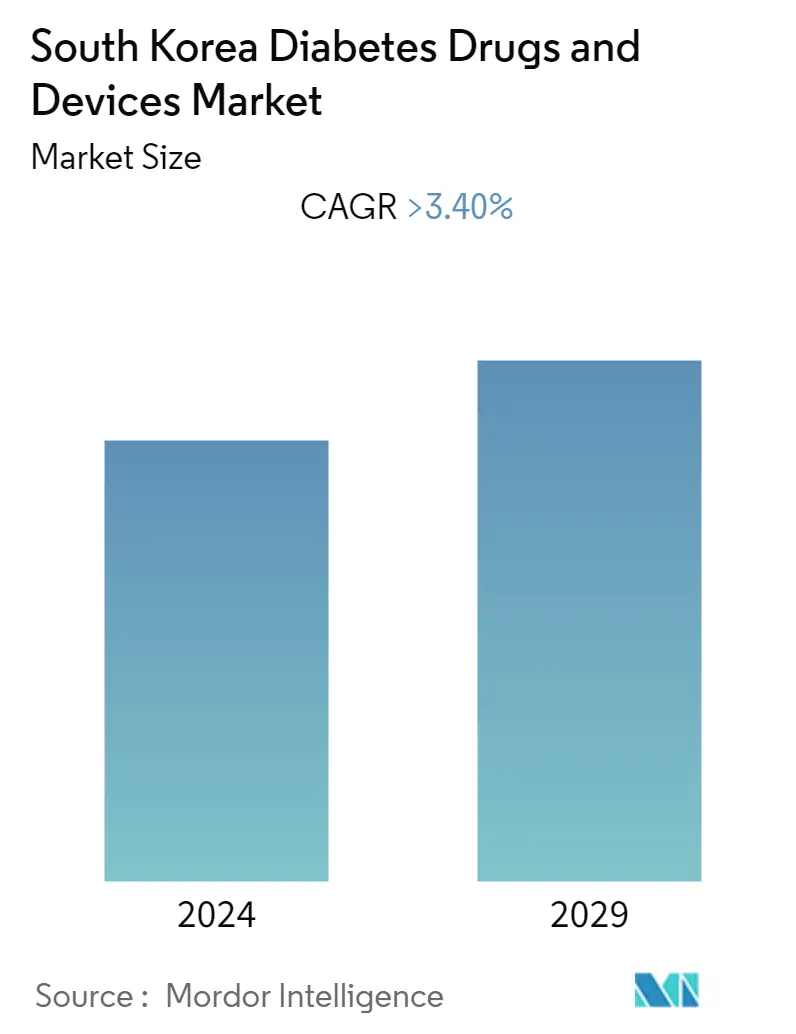
| Study Period | 2018 - 2029 |
| Base Year For Estimation | 2023 |
| Forecast Data Period | 2024 - 2029 |
| Historical Data Period | 2018 - 2022 |
| CAGR | 3.40 % |
Major Players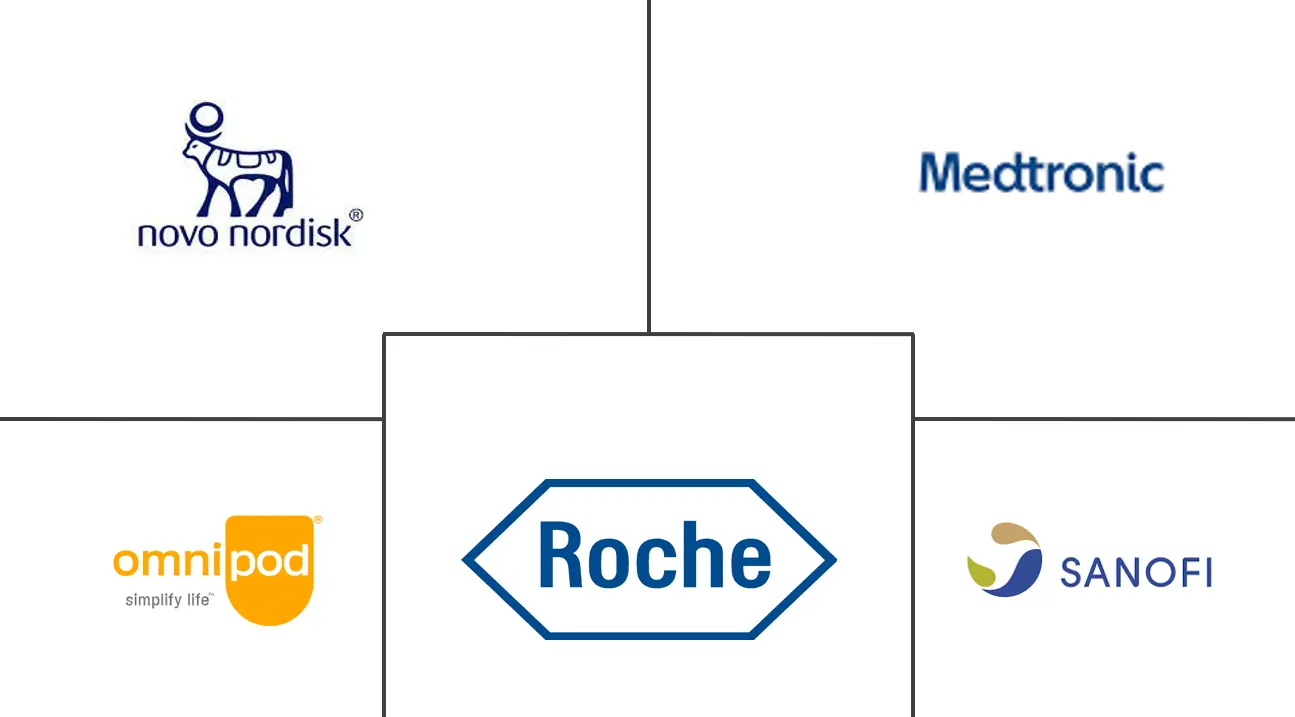
*Disclaimer: Major Players sorted in no particular order |
South Korea Diabetes Drugs and Devices Market Analysis
South Korea's diabetes drugs and devices market size is estimated at USD 1.4 billion in the current year. The market is expected to reach USD 1.7 billion in five years, registering a CAGR of more than 3.4% during the forecast period.
The COVID-19 pandemic has significantly impacted the diabetes care device market. The prevalence of diabetes in patients hospitalized with COVID-19 and evidence that improved glycemic control may improve outcomes and shorten hospital stays in patients with SARS-CoV-2 has led to a reduction in diabetes mellitus. The importance of therapeutic equipment is emphasized. The pandemic has also highlighted opportunities to continue and expand innovation in diabetes care through virtual consultations between healthcare providers and people with diabetes and the use of diabetes technology. Crisis management has led to unprecedented interest in telemedicine from patients and providers, removing many long-standing regulatory barriers. The prevalence of adult diabetes is high in South Korea, and the economic burden of diabetes is greater than that of cancer. Complications of diabetes and associated comorbidities and hospitalizations are associated with the high cost of diabetes, a cost factor. Treating patients with diabetic complications requires effective strategies to reduce the use of medical resources and the financial burden. Increased information on the extent and specific factors of the economic burden of diabetes in South Korea is expected to encourage health policymakers to prioritize prevention and treatment and allocate more healthcare resources to diabetes.
Diabetes is associated with many health complications. A diabetic need to monitor his blood sugar and make corrections many times throughout the day to maintain his nominal blood sugar, such as administering additional insulin or consuming other carbohydrates. Diabetes is a growing health burden nationwide and is a leading cause of premature death, morbidity, and loss of economic growth.
Thus, the above factors are expected to drive market growth over the forecast period.
South Korea Diabetes Drugs and Devices Market Trends
The continuous Glucose Monitoring Segment is Expected to Witness the Highest Growth Rate Over the Forecast Period
The continuous blood glucose monitoring segment is projected to grow at a CAGR of around 9.4% during the forecast period.
Continuous blood glucose monitoring is a popular alternative to standard portable finger glucose meters for people with diabetes. Continuous blood glucose monitoring sensors use glucose oxidase to measure blood glucose levels. Glucose oxidase converts glucose to hydrogen peroxidase, which reacts with platinum in the sensor to send an electrical signal to a transmitter. Various promising glucose sensor technologies are being developed, ranging from traditional electrochemical glucose sensors to new optical and other electrical glucose sensors, positively impacting the market growth. The sensor's transmitter sends blood glucose readings to a reader, receiver, or smartphone app. Receivers collect data from transmitters and display the results in various user interfaces. According to the manufacturer, different components of CGM devices have different functions. These devices may need to be applied to the skin and may be visible. Transmitter batteries are available, both disposable and rechargeable. This market segment is driven by the increasing use of CGM devices by diabetics, increasing underlying causes of diabetes, product availability in the market, benefits of these commodities, and Japanese consumption of CGM devices for use. It is expected to grow as people become more aware.
Korea's National Health Insurance is a unified compulsory health insurance system administered by the Korean government that provides medical insurance to almost all Korean citizens. South Korea's NHIS database includes socio-demographic information, access to medical services, medical billing, and health check-ups. Koreans must be registered with NHIS as having type 1 diabetes before claiming insurance reimbursement, whether expendable or CGMS. The patient only needs to confirm this by calling her NHI call center in a day or two, but the patient's doctor can also do this. The Korean required her NHI refund form, prescription, receipt, and statement to request a refund for CGM durables.
Factors such as the increasing prevalence of diabetes and increasing efforts by public and private organizations are expected to propel the market growth in this country during the forecast period.
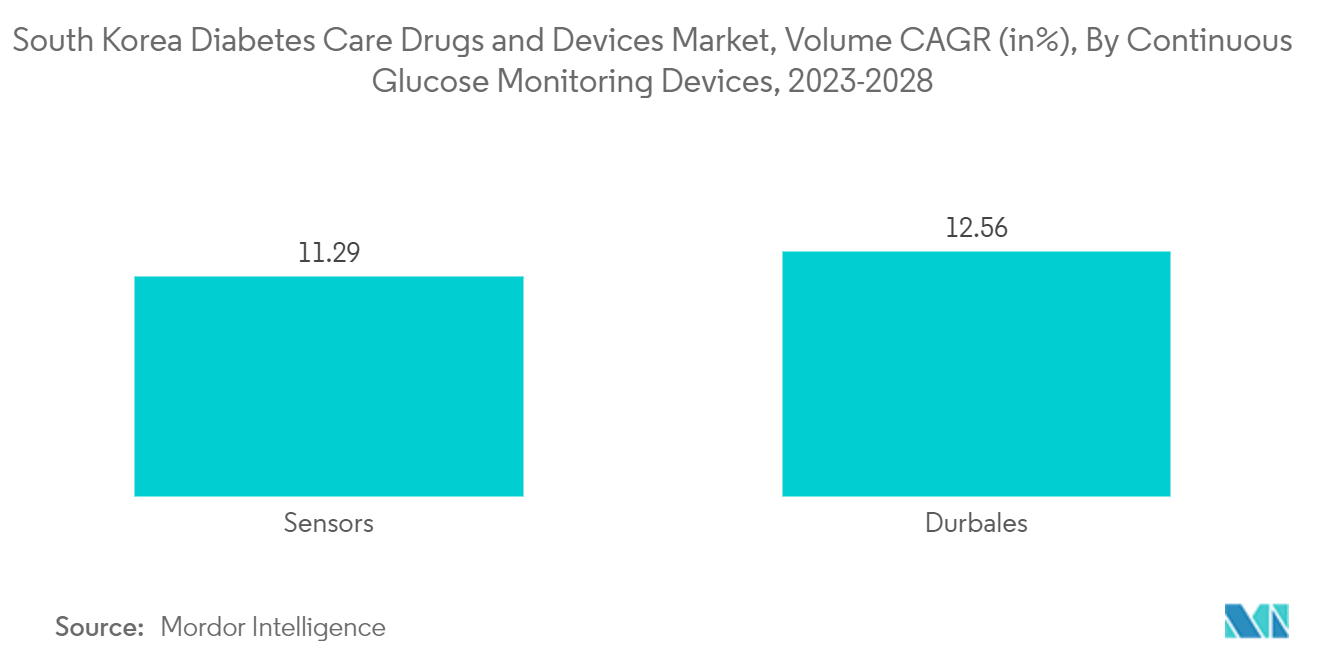
Rising diabetes prevalence
Diabetes is a major public health problem and one of the astounding challenges facing healthcare systems across South Korea. The prevalence of known type 1 and type 2 diabetes in the Korean adult population is high, and many patients still have not been diagnosed with the disease. Aging and unhealthy lifestyles (people with diabetes have a higher percentage of energy intake from carbohydrates than non-diabetics, whereas people with diabetes have a lower percentage of energy intake from protein and fat) have increased the risk of type 2. The prevalence of diabetes is higher among people with diabetes. It is expected to increase steadily over the next few years. Quality care, including appropriate surveillance, risk factor management, and active self-management, is critical to preventing complications in people with type 2 diabetes.
The frequency of monitoring blood glucose levels depends on the type of diabetes and is different for each patient. People with type 1 diabetes should have their blood sugar checked regularly, monitor their blood sugar levels, and adjust their insulin dosage accordingly. The high prevalence of type 2 diabetes comes with a significant economic burden. The cost of diabetes increases in patients with comorbidities such as hypertension and hyperlipidemia and in those who develop complications.
South Korea's medical device market regulator, the Ministry of Food and Drug Safety, will introduce several amendments to the country's medical device law and expand the list of eligible devices that can be used for electronic labeling. The prevalence of remote patient monitoring devices in the Korean market supports clinical research studies in local clinical research institutions, facilitates monitoring, and expedites discovery.
The increasing diabetes prevalence and the above factors will likely drive segment growth over the forecast period.
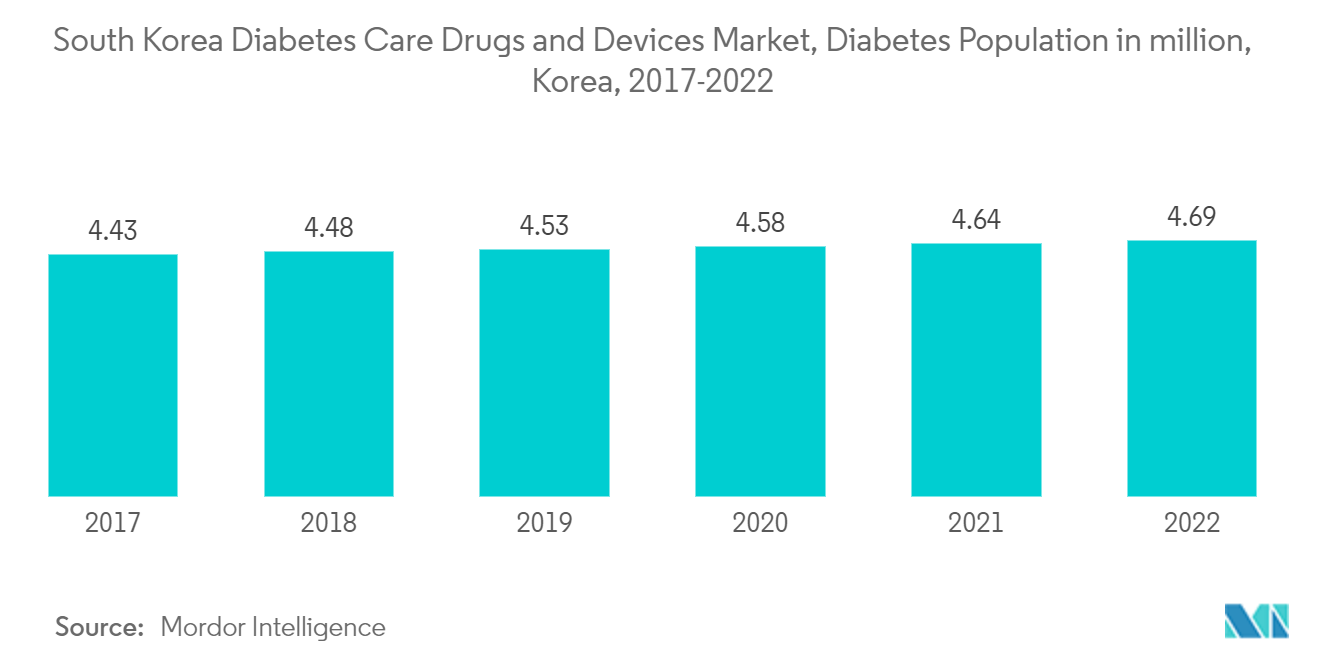
South Korea Diabetes Drugs and Devices Industry Overview
Manufacturers have always innovated to survive in the industry. Big industries, as an example, Abbott and Medtronic, have made abundant mergers, acquisitions, and partnerships to secure industry dominance while adhering to biological development techniques. The manufacturers of insulin delivery equipment are spending substantial amounts on the R&D of the gadgets. For example, Novo Nordisk partnered with Abbott Diabetes Care, which may also aid in enabling insulin data to be shared between Novo Nordisk-connected insulin pens and digital health trappings well qualified to the FreeStyle Libre portfolio of cosmetics.
South Korea Diabetes Drugs and Devices Market Leaders
-
Medtronics
-
Roche
-
NovoNordisk
-
Sanofi
-
Omnipod
*Disclaimer: Major Players sorted in no particular order
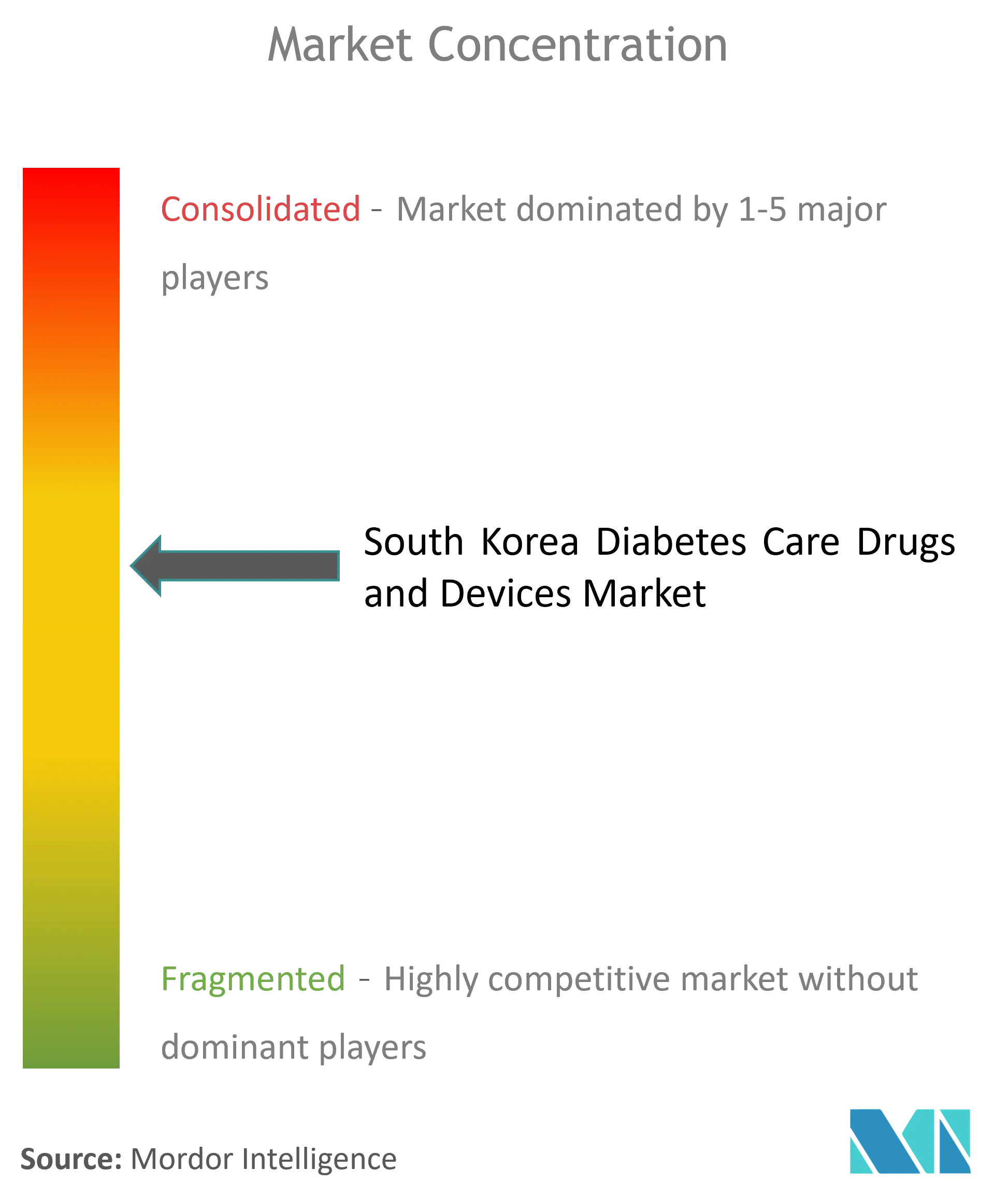
South Korea Diabetes Drugs and Devices Market News
- January 2023: Adela (Online Selling website for Abbott FreeStyle Libre in Korea) announced that the freestyle Libre selling price is expected to be raised by 10% in Korea due to a continuous rise in raw materials and inflation.
- November 2022: AstraZeneca announced new findings from a pre-specified analysis of DELIVER Phase III trial data showing that Farxiga (dapagliflozin) improved symptom burden and health-related quality of life in patients with heart failure and mildly reduced or preserved ejection fraction compared with placebo.
Table of Contents
1. INTRODUCTION
- 1.1 Study Assumptions and Market Definition
- 1.2 Scope of the Study
2. RESEARCH METHODOLOGY
3. EXECUTIVE SUMMARY
4. MARKET DYNAMICS
- 4.1 Market Overview
-
4.2 Market Dynamics
- 4.2.1 Market Drivers
- 4.2.2 Market Restraints
-
4.3 Porter's Five Forces Analysis
- 4.3.1 Bargaining Power of Suppliers
- 4.3.2 Bargaining Power of Consumers
- 4.3.3 Threat of New Entrants
- 4.3.4 Threat of Substitute Products and Services
- 4.3.5 Intensity of Competitive Rivalry
5. Market Segmentation (Market Size by Value - USD)
-
5.1 Devices
- 5.1.1 Monitoring Devices
- 5.1.1.1 Self-monitoring Blood Glucose Devices
- 5.1.1.2 Continuous Blood Glucose Monitoring
- 5.1.2 Management Devices
- 5.1.2.1 Insulin Pump
- 5.1.2.2 Insulin Syringes
- 5.1.2.3 Insulin Cartridges
- 5.1.2.4 Disposable Pens
-
5.2 Drugs
- 5.2.1 Oral Anti-Diabetes Drugs
- 5.2.2 Insulin Drugs
- 5.2.3 Combination Drugs
- 5.2.4 Non-Insulin Injectable Drugs
6. Market Indicators
- 6.1 Type-1 Diabetes Population
- 6.2 Type-2 Diabetes Population
7. COMPETITIVE LANDSCAPE
-
7.1 Company Profiles
- 7.1.1 Novo Nordisk
- 7.1.2 Medtronic
- 7.1.3 Insulet
- 7.1.4 Tandem
- 7.1.5 Ypsomed
- 7.1.6 Novartis
- 7.1.7 Sanofi
- 7.1.8 Eli Lilly
- 7.1.9 Abbottt
- 7.1.10 Roche
- 7.1.11 Astrazeneca
- 7.1.12 Dexcom
- 7.1.13 Pfizer
- *List Not Exhaustive
- 7.2 Company Share Analysis
8. MARKET OPPORTUNITIES AND FUTURE TRENDS
** Subject To AvailablitySouth Korea Diabetes Drugs and Devices Industry Segmentation
Oral diabetes medications (taken by mouth) help administer blood glucose levels in individuals who have diabetes but still produce several insulin, largely individuals with Type 2 diabetes and prediabetes. The South Korea diabetes drugs and devices market is segmented by drugs (insulin, oral anti-diabetic drugs, non-insulin injectable drugs, and combination drugs), and devices (management devices such as insulin pumps, insulin pens, syringes, cartridges, and jet injectors, and monitoring devices including self-monitoring blood and continuous glucose monitoring). The report offers the value (in USD) and volume (in unit) for the above segments.
| Devices | Monitoring Devices | Self-monitoring Blood Glucose Devices |
| Continuous Blood Glucose Monitoring | ||
| Devices | Management Devices | Insulin Pump |
| Insulin Syringes | ||
| Insulin Cartridges | ||
| Disposable Pens | ||
| Drugs | Oral Anti-Diabetes Drugs | |
| Insulin Drugs | ||
| Combination Drugs | ||
| Non-Insulin Injectable Drugs |
Frequently Asked Questions
What is the current South Korea Diabetes Drugs and Devices Market size?
The South Korea Diabetes Drugs and Devices Market is projected to register a CAGR of greater than 3.40% during the forecast period (2024-2029)
Who are the key players in South Korea Diabetes Drugs and Devices Market?
Medtronics, Roche, NovoNordisk, Sanofi and Omnipod are the major companies operating in the South Korea Diabetes Drugs and Devices Market.
What years does this South Korea Diabetes Drugs and Devices Market cover?
The report covers the South Korea Diabetes Drugs and Devices Market historical market size for years: 2018, 2019, 2020, 2021, 2022 and 2023. The report also forecasts the South Korea Diabetes Drugs and Devices Market size for years: 2024, 2025, 2026, 2027, 2028 and 2029.
South Korea Diabetes Drugs and Devices Industry Report
Statistics for the 2024 South Korea Diabetes Drugs and Devices market share, size and revenue growth rate, created by Mordor Intelligence™ Industry Reports. South Korea Diabetes Drugs and Devices analysis includes a market forecast outlook to for 2024 to 2029 and historical overview. Get a sample of this industry analysis as a free report PDF download.



